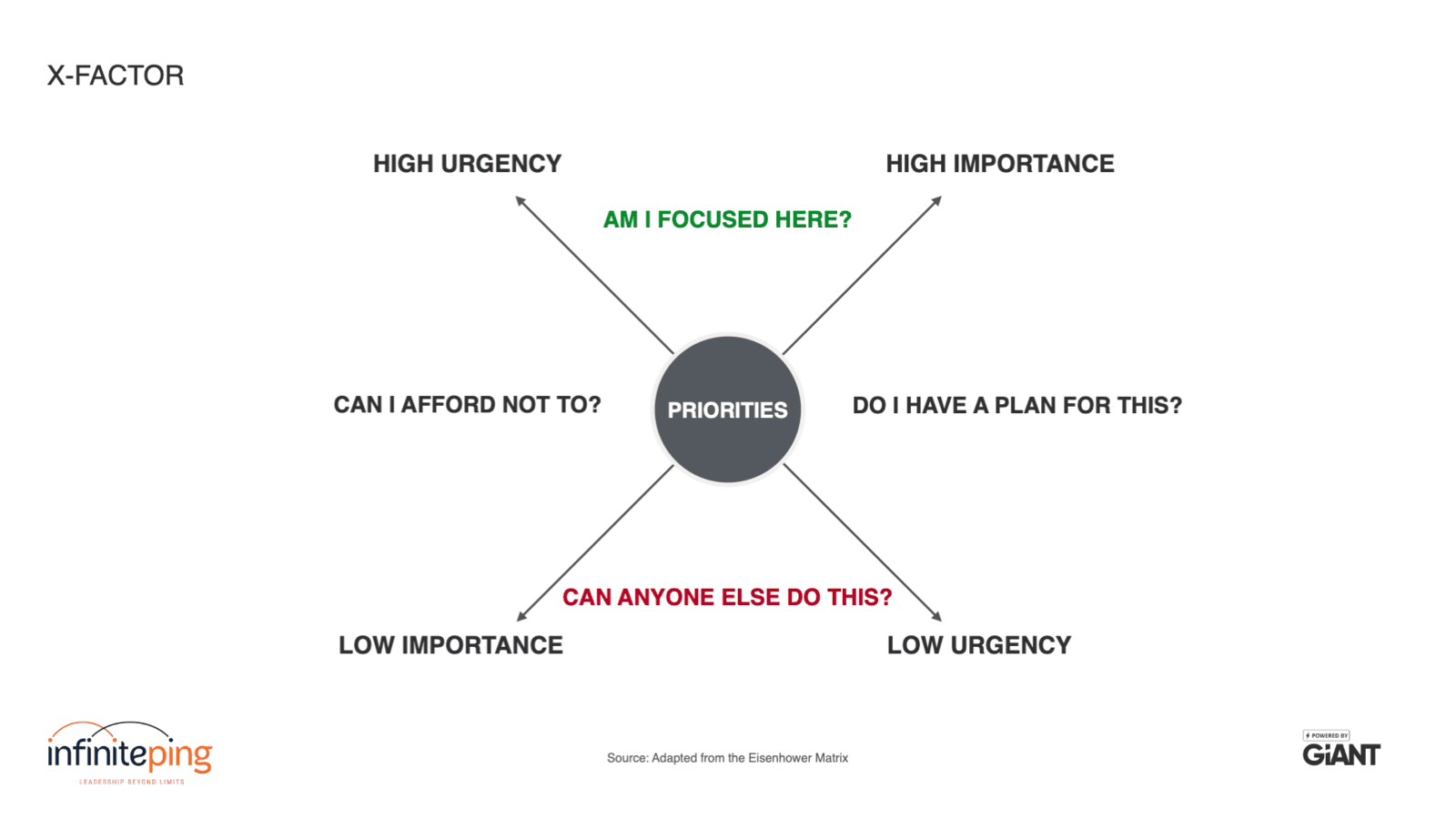Discover the revolutionary prioritization method that's helping leaders achieve more by doing less.
In today's fast-paced business world, leaders often fall into the trap of multitasking, believing it's the key to managing their overwhelming workload. However, research tells a different story. A study by Gloria Mark and her colleagues at the University of California, Irvine, found that it takes an average of 23 minutes and 15 seconds to fully refocus after switching tasks (Mark, Gonzalez, & Harris, 2005).
This "task-switching cost" isn't just about time. Multitasking diminishes our ability to manage tasks efficiently by dividing our mindset, forcing constant starts and stops, and eroding our focus. The result? Decreased productivity, increased errors, and heightened stress levels - the exact opposite of what leaders aim to achieve.
Enter the X-Factor - a revolutionary approach to time management and leadership effectiveness. Unlike the flawed multitasking model, the X-Factor method empowers leaders to achieve more by doing less. It provides a framework for laser-like focus, allowing you to cut through the noise and concentrate on what truly matters.

Understanding the X-Factor
The X-Factor is a simple yet powerful concept that can revolutionize how you approach your daily workload. At its core, it's a method of categorizing tasks based on two critical dimensions: urgency and importance. Picture a graph with these two factors as its axes. Every task, every demand on your time, can be plotted somewhere on this graph.
The beauty of the X-Factor lies in its simplicity. For each task, you ask yourself two questions: Is it urgent? Is it important? Based on the answers, you place the task in one of four quadrants, each with its own action plan:
1. High Urgency, High Importance: Immediate focus required
2. Low Urgency, High Importance: Requires planning
3. High Urgency, Low Importance: Delegation potential
4. Low Urgency, Low Importance: Reconsideration needed
Let's break down each quadrant and the key question associated with it:
1. High Urgency, High Importance: "Is it urgent and important?"
If yes, this demands immediate attention. These are your "drop everything" priorities. They're both time-sensitive and critical to your goals or responsibilities. When you identify a task in this quadrant, it's time to roll up your sleeves and dive in.
2. Low Urgency, High Importance: "Do I have a plan for this?"
These tasks are often neglected in the hustle and bustle of daily firefighting, but they're crucial for long-term success. While they don't require immediate action, you need the discipline to assign them a place in your schedule. Maybe it's blocking out time next week, or committing to work on it during your commute. The important thing is having a concrete plan.
3. High Urgency, Low Importance: "Can I afford not to address it?"
These are often the distractions that derail our day—the constant pings of email notifications or the colleague who always seems to have a "quick question." Sometimes, you can afford to ignore these. Other times, you might need to delegate or find a quick way to handle it without derailing your more important work.
4. Low Urgency, Low Importance: "Can anyone else handle this?"
If a task lacks both urgency and importance, why is it on your list at all? This is where the power of delegation really shines. If it's not important to you and not time-sensitive, it might be better handled by someone else—or not at all.
Implementing the X-Factor
To put the X-Factor into practice, follow these steps:
1. Task Inventory: List all your current tasks and commitments.
2. Categorization: Plot each task on the X-Factor matrix.
3. Action Plan: Based on the categorization, develop a strategic approach to your workload.
4. Implementation and Review: Put your plan into action and commit to regular reviews.
The Power of the X-Factor
The X-Factor isn't just a time management tool—it's a mindset shift. It empowers you to take control of your schedule and focus on what truly matters. By consistently applying this method, you can navigate the complex demands of leadership with greater ease and effectiveness.
Leaders who have implemented the X-Factor report significant improvements:
• Increased Productivity: Critical work gets completed more efficiently.
• Better Long-term Planning: Strategic initiatives are no longer neglected.
• Effective Delegation: Teams feel more empowered.
• Reduced Stress: Leaders feel more in control of their workload.
• Improved Work-Life Balance: More time for personal commitments.
Remember, the key to success with the X-Factor is regular review and adjustment. As your responsibilities evolve, so too should your approach to prioritization. Embrace this flexible, powerful tool, and watch as your productivity and job satisfaction soar.
Mastering the X-Factor: Your Path to Leadership Excellence
Take Control of Your Time Today!
Ready to revolutionize your leadership approach with the X-Factor? The journey to more effective time management and prioritization begins now, but you don't have to go it alone.
What additional resources or support would you need to implement this effectively? At Infinite Ping, we're committed to empowering leaders like you to take your performance—and that of your team—to the next level. Our expert coaching and transformative Performance Diagnostic tool can help you fine-tune your X-Factor implementation and address performance issues with empathy and precision.
Don't let another day pass drowning in a sea of tasks. Schedule an exploratory meeting with us today and start your journey towards a more focused, productive, and successful leadership style. Whether you're a seasoned executive or new to management, our tailored approach will equip you with the skills and insights you need to excel.
Take the first step towards mastering the art of prioritization and leading your team to greatness.
Connect with Infinite Ping now—your future self will thank you.
[Citation: Mark, G., Gonzalez, V. M., & Harris, J. (2005). No task left behind?: Examining the nature of fragmented work. Proceedings of the SIGCHI Conference on Human Factors in Computing Systems, 321-330.]
